Included Text
- Of Adam's first wife, Lilith, it is told
- (The witch he loved before the gift of Eve,)
- That, ere the snake's, her sweet tongue could deceive,
- And her enchanted hair was the first gold.
- And still she sits, young while the earth is old,
- And, subtly of herself contemplative,
- Draws men to watch the bright web she can weave,
- Till heart and body and life are in its hold.
- The rose and poppy are her flowers; for where
- Is he not found, O Lilith, whom shed scent 10
- And soft-shed kisses and soft sleep shall snare?
- Lo! as that youth's eyes burned at thine, so went
- Thy spell through him, and left his straight neck bent
- And round his heart one strangling golden hair.
Note: Sonnet is inscribed on the lower portion of the frame.
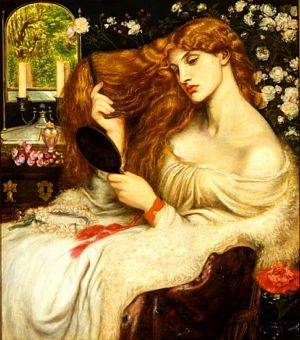
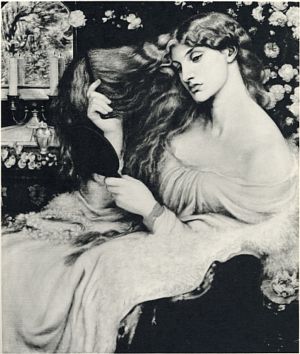
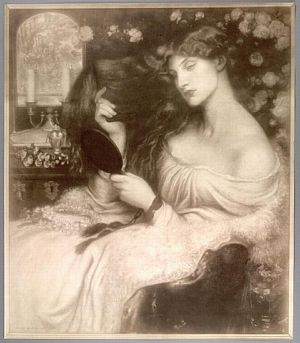
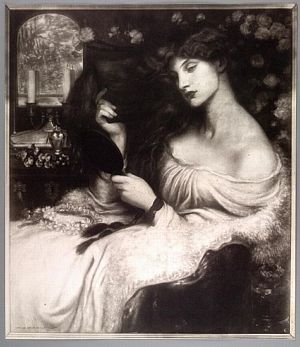
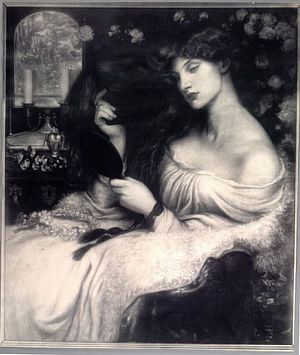
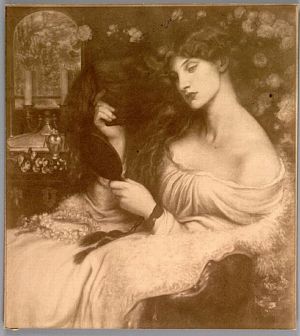
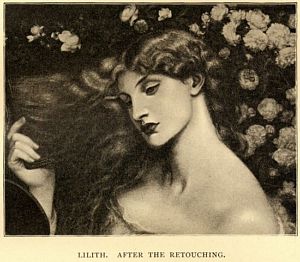
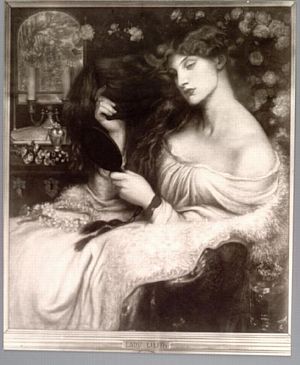
Scholarly Commentary
Introduction
The accounts of the painting by Swinburne and Stephens vividly sympathize with DGR's intention to paint a “Modern Lilith”. In this respect the picture has much in common with Manet's Olympia , where another figure of mythic eroticism is given a witty contemporary inflection. DGR's treatment has none of Manet's cynicism, however; the cool treatment is in this case an earnest (even a Victorian) representation of narcissistic and commodified beauty.
Three pictorial qualities of the picture are notable: the depthless and crowded space which Lilith dominates; the relatively unmodeled character of Lilith's exposed bosom, shoulder, and neck; and the utterly bizarre standing mirror in which we see reflected the candles in Lilith's room as well as an exterior scene from nature, or perhaps a garden.
As for the pictorial space, DGR regulates the extreme frontal plane at the lower right via the left arm of Lilith's chair, and the extreme rear plane in the frontally placed mirror at the upper left. But the painting's representation of the body of Lilith does not allow the eye to make a sharp division of those planes, and least of all to use them as definers of depth. The front of the bureau holding the mirror, color-rhyming with the left chair-arm, functions as an enclasping left chair-arm, and as such further shrinks one's sense of the painting's mid-space. Indeed, the white-on-white figure of Lilith overflows the implied space of the seat, and the irreality of the presentation is underscored by the odd angle at which upper and lower torso stand to each other. The white roses that surround the head and shoulders of Lilith further eliminate the illusion of real depth, for they extend from the plane of the chair's left arm “back” to the surface of the mirror. Furthermore, the roses themselves are laid down in a single plane and suggest floral wallpaper as much as a semi-coronal around Lilith's upper body.
The white-on-white presentation of Lilith's figure weakens the distinction between her body and her clothing, an effect heightened by the relative lack of modelling in the areas of exposed flesh. The breasts in particular have almost no definition at all so that the firmly realized head and neck seem to dissolve into a lifeless field of undifferentiated skin. This dead flesh contrasts sharply with Lilith's hair, which is meticulously detailed and highlighted.
Finally, the garden or natural scene reflected in the mirror is an impossible imagination by any realistic measure. It is as if the mirror in Lilith's enclosed and fantastic realm (or room) magically preserved a memory of the Edenic garden which she fled. The mirror of course here functions, formally speaking, as a window; but its allusion to that typical piece of pictorial symbology is negative and ironic, for it does not face (spatially) outward and (temporally) forward, but inward and backward. Furthermore, the mirror's placement suggests that if we are to imagine it reflecting anything actual, it would have to be the world inhabited by the spectator of the painting.
Production History
WMR and Marillier date the production of the first version of the painting 1864-1868 (WMR, DGR as Designer and Writer 281; Marillier, DGR: An Illustrated Memorial , 134) and this dating has remained authoritative. In fact, however, the earliest datable studies for the painting come from 1866, although two sketches from a noteboook exist and these may be earlier. The painting was commissioned by Frederick Leyland sometime early in 1866 (for 450 guineas) and DGR was working at it by August of that year (Fredeman, Correspondence, 66.144). In January 1868 he told Leyland he was all but finished with the picture, but in August he was still working on it and seems not to have sent it to Leyland until the spring of 1869. But then early in 1872 DGR began having new ideas about the picture and he asked to have it back so that he could work on it. He received the picture in February and completed his revisions on 2 December, when he sent it back to Leyland, who was pleased with the result, as was DGR. The major alteration at this stage was the substitution of Fanny Cornforth's face as Lilith with the face of Alexa Wilding (see Rossetti-Leyland Correspondence 8, 14-17, 27-37 passim). This last change has been all but universally deplored; Edelstein is one of the few who hold a contrary view. Accounts differ about whether Leyland asked to have this important change made, or whether it was DGR himself who wanted it.
Reception
The point of departure for all later responses is Swinburne's essay included as Part II of the Notes on the Royal Academy Exhibition, 1868 (pages 46-47). Of equal importance are the two important—indeed, determinative—readings of the picture given by Stephens and Marillier.
Iconograpic
DGR's remarks to his friend Hake (21 April 1870) are fundamental: “The picture is called Lady Lilith by rights (only I thought this would present a difficulty in print without paint to explain it,) and represents a ‘Modern Lilith’ combing out her abundant golden hair and gazing on herself in the glass with that self-absorption by whose strange fascination such natures draw others within their own circle.” (Fredeman, Correspondence 70.110)
Allen's excellent study of DGR's treatment of the Lilith theme draws attention to the importance of the hair iconography—in particular to the relation DGR draws between hair as a sign of erotic power and as a figure of entrapment.
DGR poses Lilith in a manner strongly reminiscent of his 1870 picture Woman with a Fan , a portrait of Fanny Cornforth.
The floral paraphernalia include a semi-coronal of white roses, which appear to signify cold sensuous love (according to legend, roses gained their red coloring only when Eve was created, at which point the rose blushed at the sight of her beauty); a crown of poppies on Lilith's lap (signifying sleep and forgetfulness); and a spray of foxglove on the bureau (signifying insincerity).
Pictorial
The immediate precursor of this work among DGR's paintings is Aurelia (Fazio's Mistress) (1862-1863), where DGR's interest in Venetian painting, stimulated a few years before, achieved a distinctive level. Titian is the principal influence here, and in particular his Lady at her Toilette , which DGR must have seen at the Louvre during his trip to Paris in late 1864. When DGR referred to Lady Lilith as “the Toilette picture” in 1866 (Fredeman, Correspondence, 66.144) he all but named Titian as his point of departure. The other related painting is Courbet's Portrait of Jo, which so closely resembles DGR's treatment that one surmises Courbet must have seen a photograph of DGR's work (probably from Whistler in 1865 when he visited Courbet in Paris with his mistress Jo, the subject of Courbet's painting).
DGR had a lifelong interest in the theme of the fatal woman, and various early drawings—e.g., the 1848 and 1855 La Belle Dame Sans Merci—have clear connections with this painting.
Historical
Allen calls attention to the contemporary relation between the figure of the femme fatale and the Women's Emancipation Movement in England. More specifically, she notes that among DGR's papers was a letter to the editor of the Athenaeum dated November 1869 in which the author, Ponsonby A. Lyons, makes the following observation: “Lilith, about whom you ask for information, was the first strong-minded woman and the original advocate of women's rights” (WMR, Rossetti Papers 1862 to 1870, 483).
Literary
The painting is part of the double work that includes the companion sonnet Body's Beauty, which is the 1881 title of the work originally called “Lady Lilith” and then “Lilith” (in its 1868 and 1870 printings respectively).
The double work should be compared with DGR's translation of a passage from Goethe (“Lilith—from Goethe”) and of course with his major work on this subject, “Eden Bower”. At least as relevant is the earlier sonnet in The House of Life , “Life-in-Love”, which is plainly recalled at the conclusion of this poem. The influence of Keats's La Belle Dame Sans Merci is equally clear—a text, it should be recalled, famous for the ambiguous presentation of the knight at arms' witch-lady.
Autobiographical
The autobiographical subtext of this work is radically conflicted. In the initial version of the painting Lilith is associated with Fanny Cornforth, but in the repainted work the face of Lilith is the same as the face DGR used to model Lilith's antithesis, the figure enshrined as Sibylla Palmifera , and for whom Alexa Wilding was the model.
Bibliography